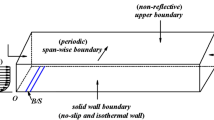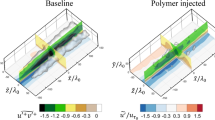Abstract
Planar particle image velocimetry was utilized to investigate the effects of localized blowing (injection) on the turbulent boundary layer over two-dimensional k-type roughness. The experiments were performed at a Reynolds number of 100,000, based on the boundary layer thickness and the free-stream velocity. The roughness was composed of identical transverse square bars at a pitch to height ratio \(p/k = 11\); the bars occupied \(\sim 13-14\%\) of the boundary layer thickness. In addition to a baseline no-injection case, localized blowing through five small spanwise jets was considered at two rates and for two injection locations. The volumetric flow rate through the jets was below 0.12% of the overall flow rate, resulting in a small perturbation to the flow field. As such, the overall flow organization is maintained across the five considered cases (baseline and four injection cases). However, the localized blowing alters the time-averaged streamwise velocity, boundary layer characteristics, Reynolds shear stress, and in-plane turbulent kinetic energy. For example, the localized blowing considered here can induce an increase up to \(\sim 6\%\) in the time-averaged streamwise velocity and a reduction up to \(\sim 20\%\) in the maximum streamwise-averaged Reynolds shear stress and turbulent kinetic energy. The blowing-induced deviations from the baseline case extend far within the boundary layer; however, two-point correlations and proper orthogonal decomposition analyses provide evidence for a similar turbulence structure far above the roughness, despite the blowing-induced deviations in the aforementioned flow quantities.
Graphic abstract












Similar content being viewed by others
References
Alam T, Saini RP, Saini JS (2014) Heat and flow characteristics of air heater ducts provided with turbulators-a review. Renew Sustain Energy Rev 31:289–304
Ashrafian A, Andersson HI (2006) The structure of turbulence in a rod-roughened channel. Int J Heat Fluid Flow 27(1):65–79
Borchetta CG, Martin A, Bailey SCC (2018) Examination of the effect of blowing on the near-surface flow structure over a dimpled surface. Exp Fluids 59(3):36
Burattini P, Leonardi S, Orlandi P, Antonia RA (2008) Comparison between experiments and direct numerical simulations in a channel flow with roughness on one wall. J Fluid Mech 600:403
Choi YK, Hwang HG, Lee YM, Lee JH (2020) Effects of the roughness height in turbulent boundary layers over rod-and cuboid-roughened walls. Int J Heat Fluid Flow 85:108644
Christensen K (2004) The influence of peak-locking errors on turbulence statistics computed from piv ensembles. Exp Fluids 36(3):484–497
Chung D, Hutchins N, Schultz MP, Flack KA (2021) Predicting the drag of roughness. Annu Rev Fluid Mech
De Marchis M, Saccone D, Milici B, Napoli E (2020) Large eddy simulations of rough turbulent channel flows bounded by irregular roughness: Advances toward a universal roughness correlation. Flow Turbul Combust 105
Dey S, Sarkar S, Ballio F (2011) Double-averaging turbulence characteristics in seeping rough-bed streams. J Geophys Res Earth Surf 116(F3)
Djenidi L, Antonia RA, Amielh M, Anselmet F (2008) A turbulent boundary layer over a two-dimensional rough wall. Exp Fluids 44(1):37–47
Djenidi L, Kamruzzaman M, Dostal L (2019a) Effects of wall suction on a 2d rough wall turbulent boundary layer. Exp Fluids 60(3):1–11
Djenidi L, Talluru KM, Antonia RA (2019b) A velocity defect chart method for estimating the friction velocity in turbulent boundary layers. Fluid Dyn Res 51(4):045502
Fang X, Yang Z, Wang BC, Tachie MF, Bergstrom DJ (2015) Highly-disturbed turbulent flow in a square channel with v-shaped ribs on one wall. Int J Heat Fluid Flow 56:182–197
Flack KA, Schultz MP (2014) Roughness effects on wall-bounded turbulent flows. Phys Fluids 26(10):101305
Flack KA, Schultz MP, Shapiro TA (2005) Experimental support for townsend’s reynolds number similarity hypothesis on rough walls. Phys Fluids 17(3):035102
Ghanadi F, Djenidi L (2021) Reynolds number effect on the response of a rough wall turbulent boundary layer to local wall suction. J Fluid Mech 916
Haddad M, Labraga L, Keirsbulck L (2006) Turbulence structures downstream of a localized injection in a fully developed channel flow. J Fluid Eng 128
Haddad M, Labraga L, Keirsbulck L (2007) Effects of blowing through a porous strip in a turbulent channel flow. Exp Therm Fluid Sci 31(8):1021–1032
Hamed AM, Peterlein AM (2020) Turbulence structure of boundary layers perturbed by isolated and tandem roughness elements. J Turbul 21(1):17–33
Hamed AM, Kamdar A, Castillo L, Chamorro LP (2015) Turbulent boundary layer over 2d and 3d large-scale wavy walls. Phys Fluids 27(10):106601
Hamed AM, Castillo L, Chamorro LP (2017) Turbulent boundary layer response to large-scale wavy topographies. Phys Fluids 29(6):065113
Hamed AM, Peterlein AM, Randle LV (2019) Turbulent boundary layer perturbation by two wall-mounted cylindrical roughness elements arranged in tandem: Effects of spacing and height ratio. Phys Fluids 31(6):065110
Healzer J, Moffat R, Kays W (1974) The turbulent boundary layer on a porous, rough plate-experimentalheat transfer with uniform blowing. In: Thermophysics and Heat Transfer Conference, p 680
Ikeda T, Durbin PA (2007) Direct simulations of a rough-wall channel flow. J Fluid Mech 571:235
Ismail U, Zaki TA, Durbin PA (2018) Simulations of rib-roughened rough-to-smooth turbulent channel flows. J Fluid Mech 843:419
Jimenez J (2004) Turbulent flows over rough walls. Annu Rev Fluid Mech 36:173–196
Kametani Y, Fukagata K (2011) Direct numerical simulation of spatially developing turbulent boundary layers with uniform blowing or suction. J Fluid Mech 681:154–172
Kametani Y, Fukagata K, Örlü R, Schlatter P (2015) Effect of uniform blowing/suction in a turbulent boundary layer at moderate reynolds number. Int J Heat Fluid Flow 55:132–142
Keirsbulck L, Labraga L, Haddad M (2006) Influence of blowing on the anisotropy of the reynolds stress tensor in a turbulent channel flow. Exp Fluids 40(4):654
Kim K, Sung HJ (2003) Effects of periodic blowing from spanwise slot on a turbulent boundary layer. AIAA J 41(10):1916–1924
Kim K, Sung HJ (2006) Effects of unsteady blowing through a spanwise slot on a turbulent boundary layer. J Fluid Mech 557:423–450
Krogstad PÅ, Efros V (2012) About turbulence statistics in the outer part of a boundary layer developing over two-dimensional surface roughness. Phys Fluids 24(7):075112
Krogstad PÅ, Kourakine A (2000) Some effects of localized injection on the turbulence structure in a boundary layer. Phys Fluids 12(11):2990–2999
Krogstad PÅ, Andersson HI, Bakken OM, Ashrafian A (2005) An experimental and numerical study of channel flow with rough walls. J Fluid Mech 530:327
Lee J, Kim JH, Lee JH (2016) Scale growth of structures in the turbulent boundary layer with a rod-roughened wall. Phys Fluids 28(1):015104
Lee JH, Seena A, Lee SH, Sung HJ (2012) Turbulent boundary layers over rod-and cube-roughened walls. J Turbul 13(1):N40
Lee SH, Sung HJ (2007) Direct numerical simulation of the turbulent boundary layer over a rod-roughened wall. J Fluid Mech 584:125–146
Lee SH, Kim JH, Sung HJ (2008) Piv measurements of turbulent boundary layer over a rod-roughened wall. Int J Heat Fluid Flow 29(6):1679–1687
Lee YM, Kim JH, Lee JH (2018) Direct numerical simulation of a turbulent couette-poiseuille flow with a rod-roughened wall. Phys Fluids 30(10):105101
Leonardi S, Orlandi P, Smalley RJ, Djenidi L, Antonia RA (2003) Direct numerical simulations of turbulent channel flow with transverse square bars on one wall. J Fluid Mech 491:229
Leonardi S, Orlandi P, Djenidi L, Antonia RA (2004) Structure of turbulent channel flow with square bars on one wall. Int J Heat Fluid Flow 25(3):384–392
Leonardi S, Orlandi P, Antonia RA (2007) Properties of d-and k-type roughness in a turbulent channel flow. Phys Fluids 19(12):125101
Liu C, Araya G, Leonardi S (2017) The role of vorticity in the turbulent/thermal transport of a channel flow with local blowing. Comput Fluids 158:133–149
Liu Z, Adrian RJ, Hanratty TJ (2001) Large-scale modes of turbulent channel flow: transport and structure. J Fluid Mech 448:53–80
Manes C, Poggi D, Ridolfi L (2011) Turbulent boundary layers over permeable walls: scaling and near wall structure. J Fluid Mech 687:141–170
Miller MA, Martin A, Bailey SCC (2014) Investigation of the scaling of roughness and blowing effects on turbulent channel flow. Exp Fluids 55(2):1675
Mori E, Quadrio M, Fukagata K (2017) Turbulent drag reduction by uniform blowing over a two-dimensional roughness. Flow Turbul Combust 99(3–4):765–785
Mousa MH, Miljkovic N, Nawaz K (2021) Review of heat transfer enhancement techniques for single phase flows. Renew Sustain Energy Rev 137:110566
Nadeem M, Lee JH, Lee J, Sung HJ (2015) Turbulent boundary layers over sparsely-spaced rod-roughened walls. Int J Heat Fluid Flow 56:16–27
Park YS, Park SH, Sung HJ (2003) Measurement of local forcing on a turbulent boundary layer using piv. Exp Fluids 34(6):697–707
Placidi M, Ganapathisubramani B (2015) Effects of frontal and plan solidities on aerodynamic parameters and the roughness sublayer in turbulent boundary layers. J Fluid Mech 782:541–566
Placidi M, Ganapathisubramani B (2018) Turbulent flow over large roughness elements: Effect of frontal and plan solidity on turbulence statistics and structure. Boundary-Layer Meteorol 167(1):99–121
Prasad A, Adrian R, Landreth C, Offutt P (1992) Effect of resolution on the speed and accuracy of particle image velocimetry interrogation. Exp Fluids 13(2):105–116
Roussinova V, Balachandar R (2011) Open channel flow past a train of rib roughness. J Turbul 12:N28
Schetz JA, Nerney B (1977) Turbulent boundary layer with injection and surface roughness. AIAA J 15(9):1288–1294
Segunda VM, Ormiston SJ, Tachie MF (2018) Experimental and numerical investigation of developing turbulent flow over a wavy wall in a horizontal channel. Eur J Mech - B/Fluids 68:128–143
Sheikholeslami M, Gorji-Bandpy M, Ganji DD (2015) Review of heat transfer enhancement methods: Focus on passive methods using swirl flow devices. Renew Sustain Energy Rev 49:444–469
Singha A, Al Faruque MA, Balachandar R (2012) Vortices and large-scale structures in a rough open-channel flow subjected to bed suction and injection. J Eng Mech 138(5):491–501
Sirovich L (1987) Turbulence and the dynamics of coherent structures. part i: Coherent structures. Q Appl Maths 45:561–571
Tachie MF, Agelinchaab M, Shah MK (2007) Turbulent flow over transverse ribs in open channel with converging side walls. Int J Heat Fluid Flow 28(4):683–707
Tachie MF, Paul SS, Agelinchaab M, Shah MK (2009) Structure of turbulent flow over 90 and 45 transverse ribs. J Turbul 10:N20
Townsend AA (1976) The structure of turbulent shear flow. Cambridge University Press, Cambridge
Tsikata JM, Tachie MF (2013a) Adverse pressure gradient turbulent flows over rough walls. Int J Heat Fluid Flow 39:127–145
Tsikata JM, Tachie MF (2013b) Effects of roughness and adverse pressure gradient on the turbulence structure. Int J Heat Fluid Flow 44:239–257
Volino RJ, Schultz MP, Flack KA (2009) Turbulence structure in a boundary layer with two-dimensional roughness. J Fluid Mech 635:75–101
Volino RJ, Schultz MP, Flack KA (2011) Turbulence structure in boundary layers over periodic two-and three-dimensional roughness. J Fluid Mech 676:172–190
Wang L, Hejcik J, Sunden B (2007) Piv measurement of separated flow in a square channel with streamwise periodic ribs on one wall. J Fluid Eng 128
Wei T, Schmidt R, McMurtry P (2005) Comment on the clauser chart method for determining the friction velocity. Exp Fluids 38(5):695–699
Xie L, Zheng Y, Zhang Y, Ye Z, Zou J (2020) Effects of localized micro-blowing on a spatially developing flat turbulent boundary layer. Flow Turbul Combust pp 1–29
Acknowledgements
This work was supported by Union College through the start-up funds of Assistant Professor A. M. Hamed, Faculty Research Fund, and Student Research Grant for C. E. Nye. The authors are thankful to GE Global Research (Niskayuna, NY) for the donation of the water channel used in this research. The authors thank undergraduate students N. Rachad and R. Gallary for their assistance with the experiments and the manuscript preparation.
Author information
Authors and Affiliations
Corresponding author
Additional information
Publisher's Note
Springer Nature remains neutral with regard to jurisdictional claims in published maps and institutional affiliations.
Rights and permissions
About this article
Cite this article
Hamed, A.M., Nye, C.E. & Hall, A.J. Effects of localized blowing on the turbulent boundary layer over 2D roughness. Exp Fluids 62, 163 (2021). https://doi.org/10.1007/s00348-021-03261-0
Received:
Revised:
Accepted:
Published:
DOI: https://doi.org/10.1007/s00348-021-03261-0




